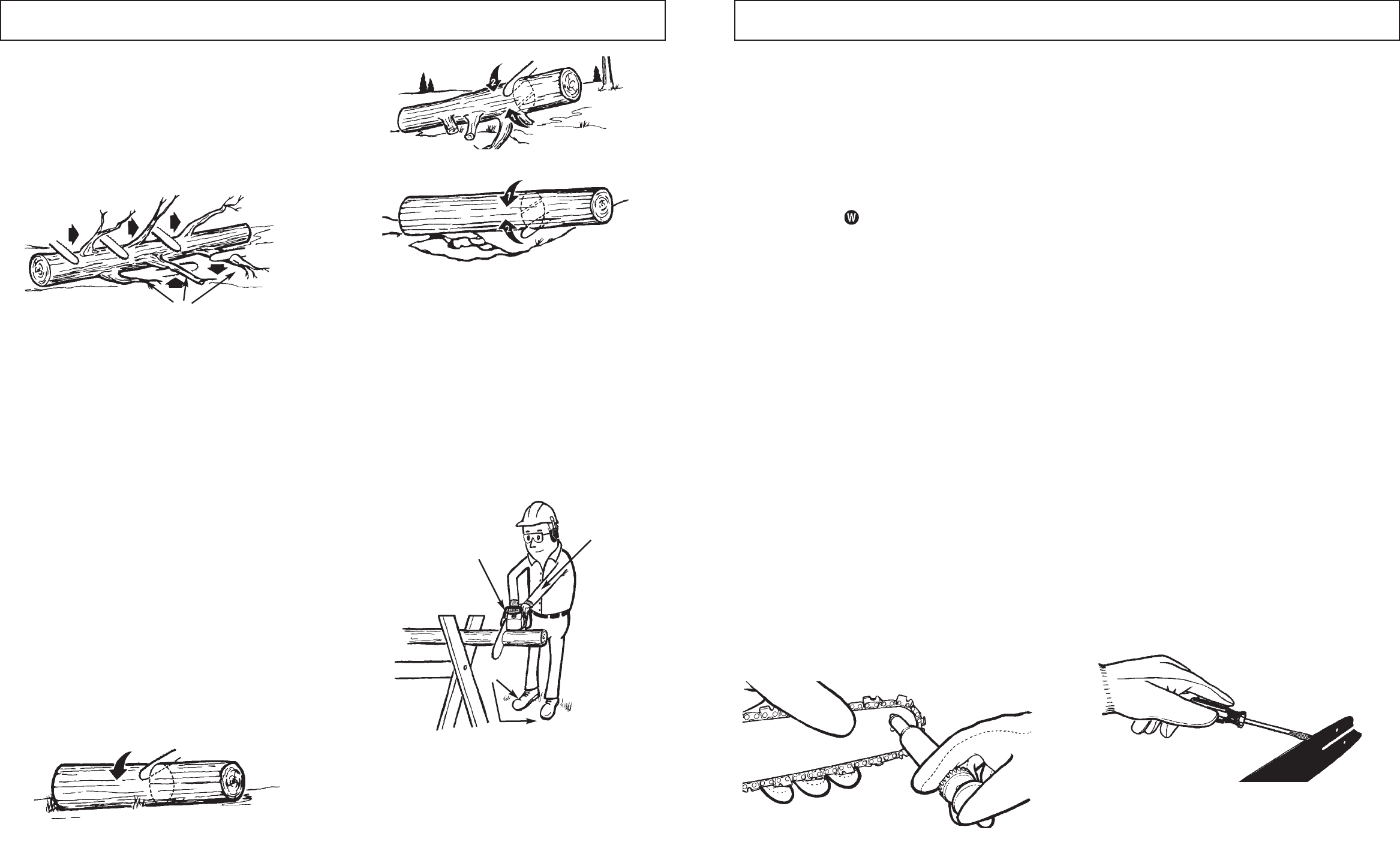
16 17
5 - GENERAL CUTTING INSTRUCTIONS
5-2. LIMBING
Limbing a tree is the process of removing the branches
from a fallen tree. Do not remove supporting limbs (A) until
after the log is bucked (cut) into lengths (Figure 5-2A).
Branches under tension should be cut from the bottom up
to avoid binding the chain saw.
WARNING
Never cut tree limbs while standing on tree trunk.
5-3. BUCKING
Bucking is cutting a fallen log into lengths. Make sure you
have a good footing and stand uphill of the log when cutting
on sloping ground. If possible, the log should be supported
so that the end to be cut off is not resting on the ground. If
the log is supported at both ends and you must cut in the
middle, make a downward cut halfway through the log and
then make the undercut. This will prevent the log from
pinching the bar and chain. Be careful that the chain does
not cut into the ground when bucking as this causes rapid
dulling of the chain.
When bucking on a slope
, always stand on the uphill side.
1. Log supported along entire length: Cut from top (over-
buck), being careful to avoid cutting into the ground
(Figure 5-3A).
2. Log supported on 1 end: First, cut from bottom (under-
buck) 1/3 diameter of log to avoid splintering. Second,
cut from above (overbuck) to meet first cut and avoid
pinching (Figure 5-3B).
3. Log supported on both ends: First, overbuck 1/3 diam-
eter of log to avoid splintering. Second, underbuck to
meet first cut and avoid pinching (Figure 5-3C).
NOTE: The best way to hold a log while bucking is to use a
sawhorse. When this is not possible, the log should be
raised and supported by the limb stumps or by using sup-
porting logs. Be sure the log being cut is securely support-
ed.
5-4.BUCKING USING A SAWHORSE
For personal safety and ease of cutting, the correct position
for vertical bucking is essential (Figure 5-4A).
VERTICAL CUTTING:
A. Hold the saw firmly with both hands and keep the saw
to the right of your body while cutting.
B. Keep the left arm as straight as possible.
C. Keep weight on both feet.
CAUTION
While the saw is cutting, be sure the chain and bar are
being properly lubricated.
5-2A
A
5-3A
5-3B
5-3C
5-4A
B
A
C
6 - BAR / CHAIN MAINTENANCE
6-1. GUIDE BAR MAINTENANCE
WARNING
Ensure that the power cord is disconnected before perform-
ing any maintenance on your saw.
Proper maintenance of the guide bar, as explained in
this section, is essential to keep your saw in good
working order.
SPROCKET TIP LUBRICATION:
(For units supplied with sprocket tip guide bars only.)
CAUTION
Failure to lubricate the guide bar sprocket tip as explained
below will result in poor performance and seizure, voiding
the manufacturer’s warranty.
Lubrication of the sprocket tip is recommended after each
saw use. Always thoroughly clean the guide bar sprocket tip
before lubrication.
Tool for lubrication: McCulloch Lube Gun (disposable)
This grease gun is designed to fit the small lubrication point
on the guide bar.
The disposable Lube Gun is packed with grease. For infor-
mation on where to purchase a lube gun, contact the McC-
ulloch Product Service Department toll-free number listed
on the back cover of this manual.
TO LUBRICATE SPROCKET TIP:
WARNING
Wear heavy duty work gloves when performing this appli-
cation to reduce risk of personal injury.
1. Unplug the chain saw from the power source.
NOTE: It is not necessary to remove the saw chain to lubri-
cate the guide bar sprocket tip. Lubrication can be done on
the job.
2. Clean the guide bar sprocket tip.
3. Using disposable Lube gun, insert tip of lube gun into
the lubrication hole and inject grease until it appears
at the outside edge of the sprocket tip (Figure 6-1A).
4. Make sure that the CHAIN BRAKE
®
is deactivated.
Rotate the saw chain by hand. Repeat the lubrication
procedure until the entire sprocket tip has been
greased.
GUIDE BAR MAINTENANCE
Most guide bar problems can be prevented merely by keep-
ing the chain saw well maintained.
Incorrect filing and non-uniform cutter and depth gauge set-
tings cause most guide bar problems, primarily resulting in
uneven bar wear. As the bar wears unevenly, the rails
widen, which may cause chain clatter and difficulty in mak-
ing straight cuts.
Insufficient guide bar lubrication and operating the saw with
a chain that is TOO TIGHT will contribute to rapid bar wear
(see Section 6-2).
To help minimize bar wear, the following guide bar mainte-
nance is recommended.
BAR WEAR - Turn guide bar frequently at regular intervals
(for example, after 5 hours of use), to ensure even wear on
top and bottom of bar.
BAR GROOVES - Bar grooves (or rails which support and
carry the chain) should be cleaned if the saw has been
heavily used or if the saw chain appears dirty. Rails should
always be cleaned every time the saw chain is removed.
OIL PASSAGES - Oil passages at bar pad should be
cleaned to ensure proper lubrication of the bar and chain
during operation. This can be done using a soft wire small
enough to insert into the oil discharge hole.
NOTE: The condition of the oil
passages can be easily
checked. If the passages are clear, the chain will automati-
cally give off a spray of oil within seconds of starting the
saw. Your saw is equipped with an automatic oiler system.
TO CLEAN GUIDE BAR RAILS:
1. Remove sprocket cover, bar and chain. (see Section
3-3)
2. Using a screwdriver, putty knife, wire brush or other
similar instrument, clear residue from the rails on the
guide bar. This will keep the oil passages open to pro-
vide proper lubrication to the bar and chain (Figure 6-
1B).
3. Reinstall the bar, chain, sprocket cover and bar bolt
knob. (See Section 3-3).
6-1A
6-1B


















